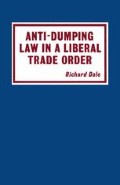Abstract
The world steel industry has always been characterised by ‘dual’ or double’ pricing, the industry’s expression for price discrimination between home and export markets. Similarly, the steel industry’s problems have been very much to the fore in discussions of anti-dumping policy, a prominence which has become more pronounced with the emergence in recent years of chronic excess steel-making capacity throughout the industrialised world. In 1977/78, the steel dumping problem came to a head when several countries followed the American example in adapting their anti-dumping policies to curb ‘below cost’ steel imports, a development which transformed the international steel market and which may have established a precedent for dealing with similar situations in other industrial sectors. Because of steel’s central role in the evolution of the dumping/anti-dumping problem it merits a chapter to itself.
Access this chapter
Tax calculation will be finalised at checkout
Purchases are for personal use only
Preview
Unable to display preview. Download preview PDF.
Notes and References
Duncan Lyall Burn, The Economic History of Steelmaking 1867–1939 (Cambridge: Cambridge University Press, 1940) chs VII and XII.
See Klaus Stegemann, Price Competition and Output Adjustment in the European Steel Market (Tübingen: Möhr, 1977) pp. 131–6.
Lennart Friden, Instability in the International Steel Market (Stockholm: Beckmans, 1972) pp. 34–5.
William Diebold Jr, The Schuman Plan (New York: Praegar, 1959) p. 491.
William Seavey, Dumping since the War: The GA TT and National Laws, Thesis no. 205 (Oakland, California: Office Services Corp., 1970) pp. 93–4.
The authors of a painstaking assessment of this Code concluded that ‘ … the absence of well established price leadership in the face of simultaneous and identical action among groups of independents establishes a presumption that prices were altered under the Code by predetermined agreement’. C. R. Daugherty, M. G. de Chazeau and S. S. Stratton, Economics of the Iron and Steel Industry (New York: McGraw Hill, 1937) p. 671.
George F. Stocking and Myron W. Watkins, Cartels in Action (New York: Twentieth Century Fund, 1946) pp. 201–2.
Ervin Hexner, The International Steel Cartel (Chapel Hill: North Carolina University Press, 1943) pp. 213–14.
Walter Adams, ‘The Steel Industry’, in Walter Adams (ed.), The Structure of American Industry (New York: Macmillan, 1961) p. 169.
This view is supported by G. J. Stigler and J. K. Kindahl, Behaviour of Industrial Prices (New York: National Bureau of Economic Research, 1970) pp. 74–5.
Staff Study of the Committee on Finance, Steel Imports (Washington: US Government Printing Office, for the United States Senate, 1967) p. xxii.
William Adams Brown Jr, The United States and the Restoration of World Trade (Washington: Brookings Institution, 1950) p. 126.
See Klaus Stegemann, ‘Three Functions of the Basing-point pricing and Article 60 of the ECSC Treaty’, Antitrust Bulletin, vol. 13, 1968, pp. 403–4.
See Louis Phlips, Spatial Pricing and Competition (Brussels: Competition: Approximation of Legislation Series, 1976). The author concludes: ‘in oligopolistic industries producing heavy goods of low unit value, these [basing point] systems indicate the existence of tacit price-fixing agreements. They should be prohibited if the prohibition of price-fixing agreements is to work.’ Ibid., p. 54.
For a summary of this incident see Louis Lister, Europe’s Coal and Steel Community: An Experiment in Economic Union (New York: Twentieth Century Fund, 1961) p. 221.
See Alastair Forsyth, Steel Pricing Policies: A Comparative Study of the ECSC and the British and American Systems (London: PEP, 1964) p. 351.
Yoshio Kanazawa, ‘The Regulation of Corporate Enterprise: The Law of Unfair Competition and the Control of Monopoly Power’, in Arther von Mehren (ed.), Law in Japan (Cambridge, Mass.: Harvard University Press, 1963) p. 505. The Anti-monopoly Act was, however, tightened up through a legislative amendment in June 1977: see OECD Annual Report on Competition Policy (Paris: OECD Secretariat, 1978) pp. 61 et seq.
Kiyoshi Kawahito, The Japanese Steel Industry: With an Analysis of the US Steel Import Problem (Irvington: Special Studies in International Economics and Development, 1972) p. 127.
Kiyoshi Kawahito, Export Promotion Measures of the Japanese Government with Special Reference to the Steel Industry (Murfreesboro: Middle Tennessee State University, 1973). In 1977, MITI tried to introduce an antirecession cartel for steel bars which would have involved sanctions against non-adherents. One such non-adherent, Tokyo Seitsu, reputedly the most efficient firm in the industry, took legal proceedings in an attempt to resist this move. See Comment by Professor Okano in G. C. Allen, op. cit., p. 60.
Frederick Scherer, Industrial Pricing: Theory and Evidence (Chicago: Rand McNally, 1970) pp. 64–70.
For consideration of the elasticity question see Charles K. Rowley, Steel and Public Policy (London: McGraw Hill, 1970) pp. 215 et seq.
Alfred Oxenfeldt, Industrial Pricing and Market Practices (New York: Prentice-Hall, 1951) p. 491.
Author information
Authors and Affiliations
Copyright information
© 1980 Richard Dale
About this chapter
Cite this chapter
Dale, R. (1980). Dumping and the Steel Industry. In: Anti-Dumping Law in a Liberal Trade Order. Trade Policy Research Centre. Palgrave Macmillan, London. https://doi.org/10.1007/978-1-349-05045-1_6
Download citation
DOI: https://doi.org/10.1007/978-1-349-05045-1_6
Publisher Name: Palgrave Macmillan, London
Print ISBN: 978-1-349-05047-5
Online ISBN: 978-1-349-05045-1
eBook Packages: Palgrave Economics & Finance CollectionEconomics and Finance (R0)

